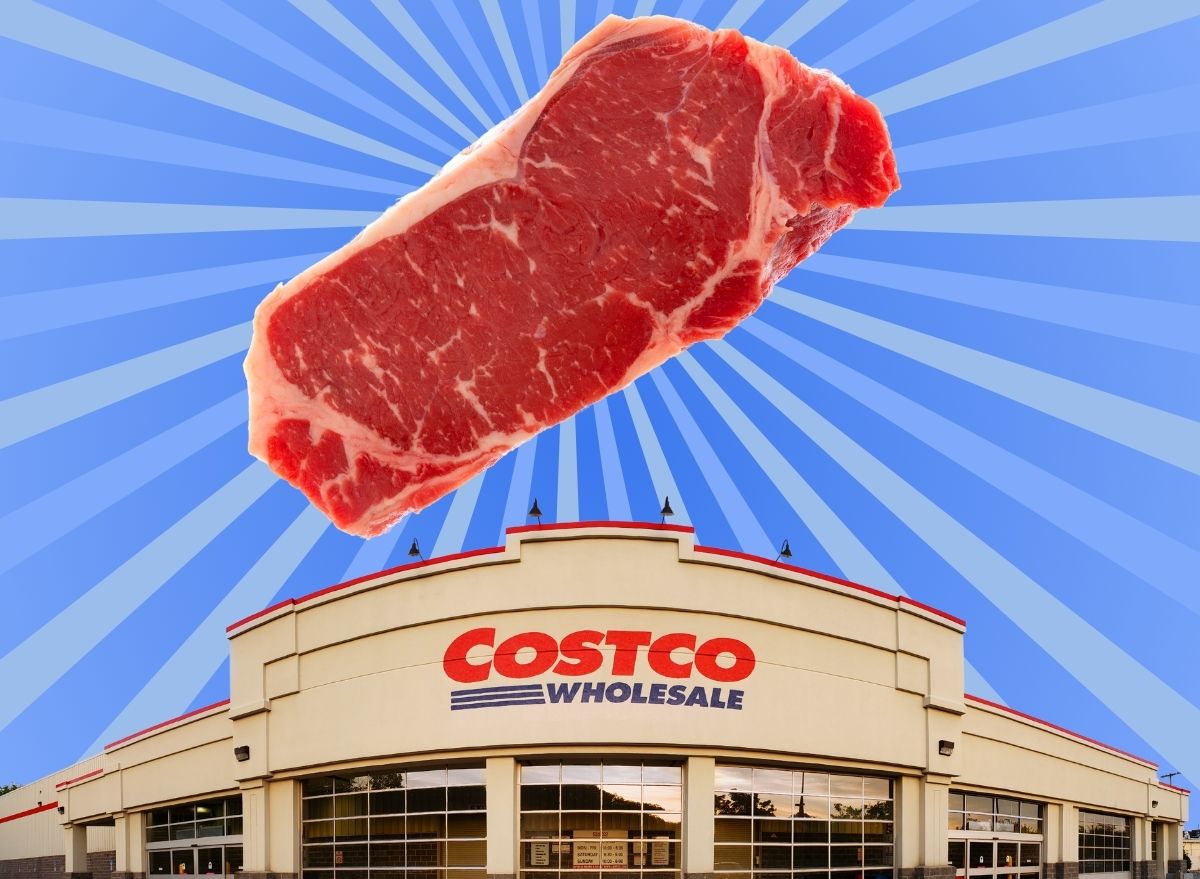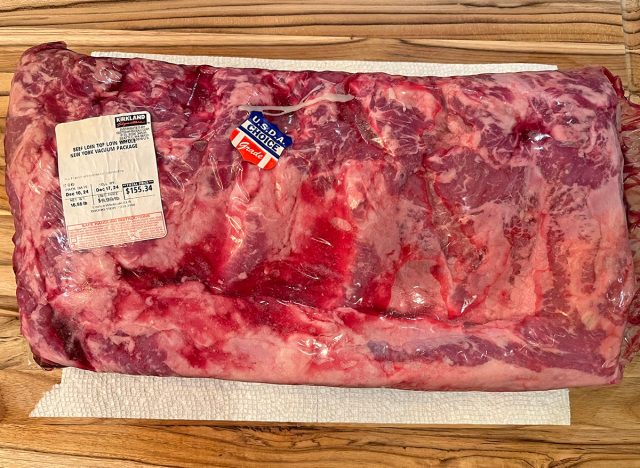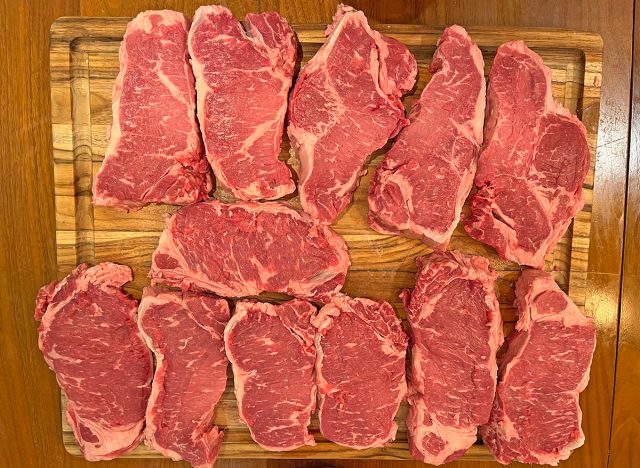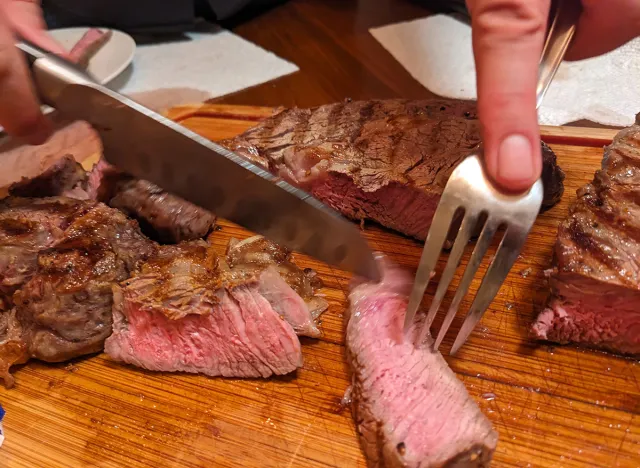The #1 Best Costco Hack To Save Money on Steak

Shoppers flock to Costco for good deals on all kinds of groceries, from frozen foods to fresh bakery items. You can also find some unbeatable bargains in the meat department.
My personal favorite cut of steak to cook at home, the noble New York strip, is currently priced as low as $11.99 per pound at my local Costco warehouse in Brooklyn, N.Y. The nearest Whole Foods Market charges more than twice that price! Costco’s comparatively affordable cuts come in packs of five, all trimmed up and ready to sear.
If you want to save even more money on this luscious steak, you can try a relatively easy hack that’s been circulating online. And by “hack,” I mean it quite literally. All it takes is a sharp knife and a little elbow grease. You’ll end up with a stockpile of fresh meat and a stack of extra cash left in your wallet to boot.
The first step is to bypass the packages of shrink-wrapped, pre-cut steaks you’re used to buying at Costco. Instead, look for the hulking, vacuum-sealed, whole strip loin.
That’s right—you’re going to slice it up into steaks yourself. It’s actually not as difficult as it sounds.
I recently tried this DIY method myself, taking cues from Anthony Bartleson, aka “Meat Dad” on Instagram. This Costco-shopping, self-described butcher of 20 years regularly offers tips for saving money at the meat counter. Carving your own steaks from whole slabs is one of his most frequent suggestions. You can use the same technique to turn whole beef tenderloins into filet mignons or whole rib sections into ribeyes, but for this exercise, I stuck with my fave, the New York steak.
In a video, Bartleson demonstrates how to break down the whole loin, describing it as “a really easy place to start if you wanna save some dough.”
Jump to Section
- Step 1: Select your whole loin
- Step 2: Slice to your preferred thickness
- Step 3: Preserve your beefy bounty
Step 1: Select your whole loin

For my own meat-carving experiment, I picked up a 15.5-pound whole beef loin at Costco, which cost me $155.34. I found it right beside the pre-cut New York steaks. It’s a heftier investment than the $67.14 that I previously paid for a 5.6-pound pack of the same USDA Choice-grade meat, but the return is equally considerable.
That’s how bulk buying works: you pay more upfront for a bigger quantity, saving money on the price-per-unit in the long run. In this case, the whole loin cost $9.99 per pound versus $11.99 per pound for the pre-cut steaks. That translates to around $30 in savings for over 15 pounds of meat.
Don’t forget your shopping cart: this 15-pounder was the smallest loin that I could find in the cooler, and that weight can be a real drag if you choose to haul it yourself all the way to the register.
Step 2: Slice to your preferred thickness

The real fun begins when you get that hulking meat slab home. Slip on some latex or nitrile gloves and grab your knife to get started.
Ideally, you’ll cut the bag open over the sink, so you can carefully drain the excess juices before slicing. My package contained a considerable amount of liquid. Once it’s drained, you can carefully slide the meat onto a carving board, preferably a large one.
The beauty of carving steaks yourself is that you can slice them as thick or thin as you like. The pre-cut steaks at Costco are usually about an inch and a half thick, so I tried to copy that as closely as possible for a proper comparison.
The all-white fat cap side of the meat can be tougher to slice through, so I positioned the loin with the fleshier side down (as Bartleson does in the video). That way you can cut into the cap right away, and get the hardest part over with first. Point the tip of the blade at a downward angle for maximum effectiveness. Once you get past the fat cap, the knife slides through the rest of the meat quite easily.
After carving up the individual steaks, you can trim the fat from each cut. Bartleson recommends slicing it down to about a quarter-inch on each piece.
Working my way through the entire slab, I ended up with a total of 12 steaks, a heaping bowl full of trimmings, and a little red blister on my right index finger from all the carving. The whole process took less than 30 minutes.
Step 3: Preserve your beefy bounty

Just two of these thick steaks is enough to feed my family of four. So, of course, you’ll want to properly store the rest in the freezer for many meals yet to come. If you have a vacuum sealer, use it. Otherwise, fully cover each steak in plastic wrap, then place inside a tightly sealed freezer bag for optimal preservation.
Beyond the simple cost savings, there’s another reason to cut your own steaks: food safety. All the pre-cut steaks at Costco are “blade tenderized,” a process whereby mechanized needles are used to pierce the meat and break down its muscle fibers to make it more tender.
It’s a controversial technique that is frequently debated among Costco shoppers on Reddit. Critics argue the process can create a pathway for bacterial contamination, while defenders of the practice suggest that Costco is hyper vigilant about regularly sterilizing its equipment to minimize any risk. Nevertheless, Costco puts a warning on all its pre-cut steaks, recommending that you cook them to an internal temperature of 145 degrees. That’s “medium-well” in meat-eating parlance—and a total non-starter for folks who prefer their steaks more rare.
Costco’s whole loins, meanwhile, are not blade tenderized and carry no such warning.
As someone who’s enjoyed countless pre-cut Costco steaks and always cooked them medium-rare, I’ve personally never had a problem. And as someone who’s now cut his own steaks from the non-tenderized loins, I honestly can’t tell much difference in texture or flavor between the two methods.
But if you’re looking to play it safe—and save money at the same time—then carving your own steaks is the way to go.
Why Trust Eat This, Not That!?
Eat This, Not That! is committed to creating high-quality content that you can trust to be accurate, properly researched, routinely reviewed, and updated with the latest information. Our writers, editors, and medical and/or certified experts consider this to be an unwavering promise we make to our readers in the pursuit of delivering impactful and meaningful content.









